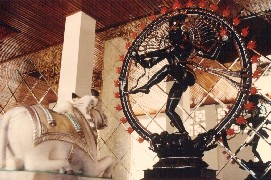 |
 |
|
 |
 |
SHIVA

"Beyond this darkness there is neither day or night,
neither existence nore nonexistence but Shiva alone, the indestructible.
EVen the sun lies prostrate before him.
From him springs ageless wisdom."
Svetasvatara Upanisad 4.18 [325]
"He is without beginning, middle or end:
the One, omnipresent,
wonderful, the joy of the mind, the consort of Peace-of-night (Uma),
the supreme deity, the supreme lord,
three-eyed, blue-throated, tranquil.
He is the Creator, lord of sleep,
and Indra, the lord of heaven;
indestructible, supreme, self-resplendent.
He is the Pervader, the life breath,
the fire of destruction, and the devoured offering (the Moon).
He is all that has been or shall be, eternal.
Knowing him, one crosses beyond death.
There is no other way to liberation."
Kaivalya Upanisad 6-9 [356]
Shiva is the most powerful and feared god of the Hindu trinity, the other members of the trinity being Brahma (the creator) and Vishnu (the preserver). The first Shiva murti is in the main mandir. The mandir also contains a murti of Parvati, consort of Shiva, and a lingam. This mandir is quite lively during Shivratri, the festival held in the fourteenth night of the dark half moon in January or February, when devotees queue to make offerings to this powerful deity and do Shiva puja.
The origins of Shiva can be traced to Rudra, the destructive storm God or lord of tears, of the Rig Veda. Shiva is the god associated with destruction; the personification of disintegration or tamas. Shiva also has a more benevolent aspect in that he represents satyam, shivam, sundaram: truth, goodness and beauty. "Shiv" also means good. Shiva has been worshipped in his present form since about 300BC. His followers in India are known as Saivites, rivalled in number by the followers of Vishnu or the Vaishanvites. Shiva is a deity of many different aspects and has 1008 names which are listed in the Shiv Purana. He is described as a boundless void, and is compared to the silence and emptiness of sleep. Unlike Vishnu, who incarnates in the form of the different avatars, Shiva's powers are demonstrated by his different identities. Some of the most well known identities are: Bhairava, the destroyer or lord of the ghosts; Bhutesvara, lord of the ghosts or the elements; Hara, death; Sambhu, the abode of joy in which the universe sleeps; Sankara, the giver of joy; Mahesvara, the lord of knowledge; Mahayogi or the lord of yoga; and Nataraj or the lord of the dance. Shiva is also associated with time and is identified as time or the destroyer of the worlds by the Mahabharata. His consort is Parvati, a goddess who also takes the forms of Gauri, Uma, Durga or Kali. Shiva has two two sons with Parvati, Ganesh and Kartikreya. According to Hindu mythology, Shiva resides on Mount Kailash, in the Himalayas, where he spends his time in deep meditation.
The Shiva murti with the crescent moon symbolising the power of creation on his brow on his brow. His three eyes represent the sun, moon and fire: the sources of light. Shiva's third eye on his forehead symbolises higher perception and gazes inwards. When directed outside, the third eye destroys everything before it. The juxtaposition of the moon and the third eye shows the co-existence of creation and destruction. Astride Shiva's matted hair is Vayu, the lord of the wind who is connected with the flow of offering. The Ganges flowing from Shiva's matted locks represents ritual purification. The tiger skin on which Shiva sits shows the superiority of his power to that of nature. The snakes peering out of Shiva's hair represent the fact that Shiva is beyond the power of death but is always surrounded by death. They also represent kundalini or the energy which is the source of all spiritual conquests.
NATARAJA

Nataraja, the dancing form of Shiva, represents darkness and time. The dance of Nataraja represents the destruction and creation of the universe and the cycles of birth and rebirth. Nataraja, hair flying at the sides crushes the demon of ignorance under his feet, while one hand stretched across his chest, points to his uplifted foot to represent the release of the devotee from maya. In one arm he holds the ashes of the fire with which he destroyed the universe, and a cobra dangles from the other. Nandi, the white bull who is the vehicle of Lord Shiva, faces Nataraja. He serves as a guard of the Nataraja shrine. In Hindu mythology, Nandi is the embodiment of fertility.
Mantras
Om Namah Shivaya
Jaya Jaya Siva Sambho Mahadeva Sambho
Sloka
Om Tryambakam yajamahe
Sugandhim pustivardhanam
Urvaarukamiva bandhanat
Mrityormuksheeya maamritat
Translation:
We worship the three-eyed One (Lord Siva)
Who is fragrant and who nourishes
all beings;